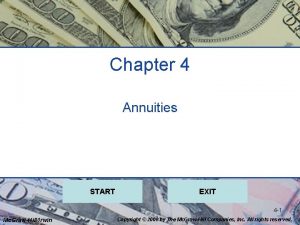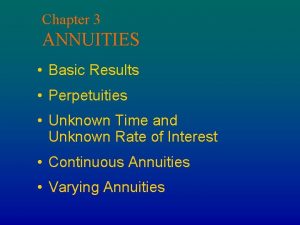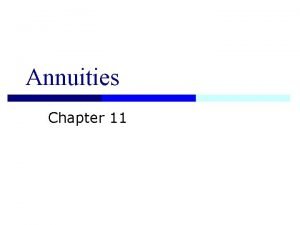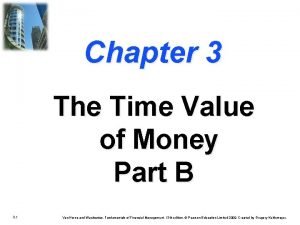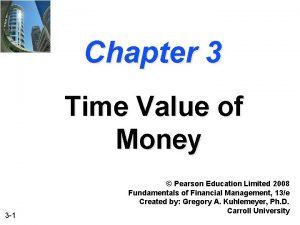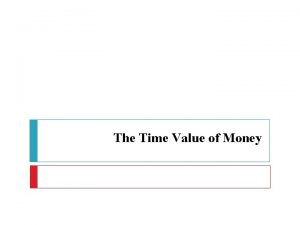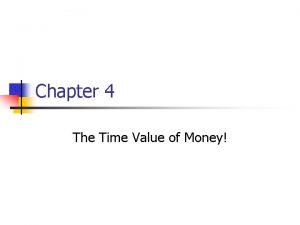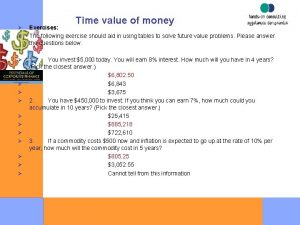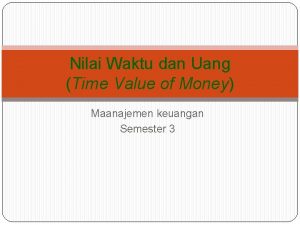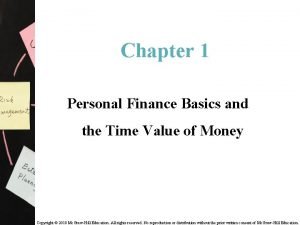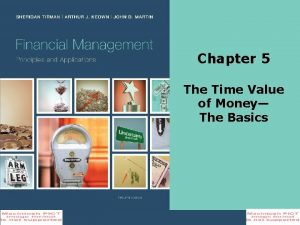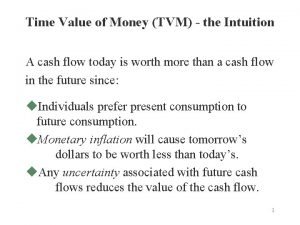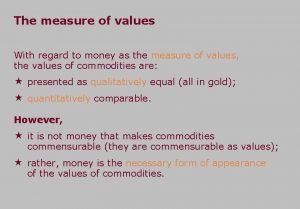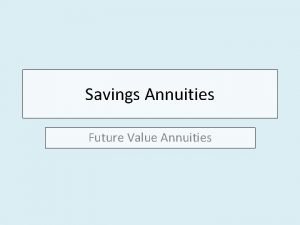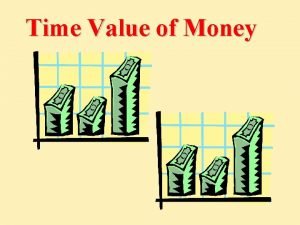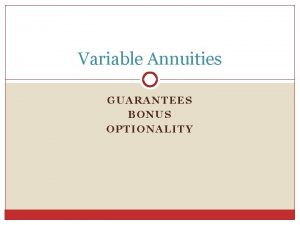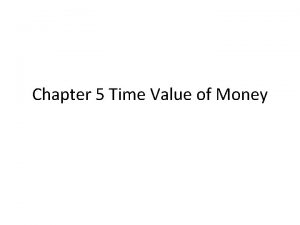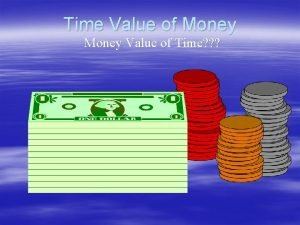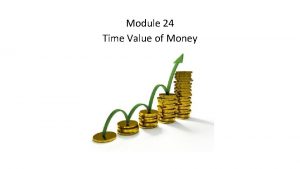Chapter 6 The Time Value of Money Annuities








































- Slides: 40

Chapter 6 The Time Value of Money: Annuities and Other Topics Copyright © 2011 Pearson Prentice Hall. All rights reserved.

Slide Contents • Learning Objectives • Principles Used in This Chapter 1. Annuities 2. Perpetuities 3. Complex Cash Flow Streams Copyright © 2011 Pearson Prentice Hall. All rights reserved. 5 -2

Learning Objectives 1. Distinguish between an ordinary annuity and an annuity due, and calculate present and future values of each. 2. Calculate the present value of a level perpetuity and a growing perpetuity. 3. Calculate the present and future value of complex cash flow streams. Copyright © 2011 Pearson Prentice Hall. All rights reserved. 5 -3

6. 1 Annuities Copyright © 2011 Pearson Prentice Hall. All rights reserved.

Ordinary Annuities • An annuity is a series of equal dollar payments that are made at the end of equidistant points in time such as monthly, quarterly, or annually over a finite period of time. • If payments are made at the end of each period, the annuity is referred to as ordinary annuity. Copyright © 2011 Pearson Prentice Hall. All rights reserved. 5 -5

Ordinary Annuities (cont. ) • Example 6. 1 How much money will you accumulate by the end of year 10 if you deposit $3, 000 each for the next ten years in a savings account that earns 5% per year? • We can determine the answer by using the equation for computing the future value of an ordinary annuity. Copyright © 2011 Pearson Prentice Hall. All rights reserved. 5 -6

The Future Value of an Ordinary Annuity • FVn = FV of annuity at the end of nth period. • PMT = annuity payment deposited or received at the end of each period • i = interest rate period • n = number of periods for which annuity will last Copyright © 2011 Pearson Prentice Hall. All rights reserved. 5 -7

The Future Value of an Ordinary Annuity (cont. ) • FV = $3000 {[ (1+. 05)10 - 1] ÷ (. 05)} = $3, 000 { [0. 63] ÷ (. 05) } = $3, 000 {12. 58*} = $37, 740 (*use appendix D) Copyright © 2011 Pearson Prentice Hall. All rights reserved. 5 -8

Solving for PMT in an Ordinary Annuity • Instead of figuring out how much money you will accumulate (i. e. FV), you may like to know how much you need to save each period (i. e. PMT) in order to accumulate a certain amount at the end of n years. • In this case, we know the values of n, i, and FVn in equation 6 -1 c and we need to determine the value of PMT. Copyright © 2011 Pearson Prentice Hall. All rights reserved. 5 -9

Solving for PMT in an Ordinary Annuity (cont. ) • Example 6. 2: Suppose you would like to have $25, 000 saved 6 years from now to pay towards your down payment on a new house. If you are going to make equal annual endof-year payments to an investment account that pays 7 per cent, how big do these annual payments need to be? Copyright © 2011 Pearson Prentice Hall. All rights reserved. 5 -10

Solving for PMT in an Ordinary Annuity (cont. ) • Here we know, FVn = $25, 000; n = 6; and i=7% and we need to determine PMT. • $25, 000 = PMT {[ (1+. 07)6 - 1] ÷ (. 07)} = PMT{ [. 50] ÷ (. 07) } = PMT {7. 153} $25, 000 ÷ 7. 153 = PMT = $3, 495. 03 Copyright © 2011 Pearson Prentice Hall. All rights reserved. 5 -11

The Present Value of an Ordinary Annuity • The present value of an ordinary annuity measures the value today of a stream of cash flows occurring in the future. • For example, we will compute the PV of ordinary annuity if we wish to answer the question: what is the value today equivalent of receiving every year for the next years if the interest rate is fixed? Copyright © 2011 Pearson Prentice Hall. All rights reserved. 5 -12

The Present Value of an Ordinary Annuity (cont. ) • PMT = annuity payment deposited or received at the end of each period. • i = discount rate (or interest rate) on a period basis. • n = number of periods for which the annuity will last. Copyright © 2011 Pearson Prentice Hall. All rights reserved. 5 -13

What is the present value of an annuity of $10, 000 to be received at the end of each year for 10 years given a 10 percent discount rate? • Using the Mathematical Formula [ • PV = $10, 000 { 1 -(1/(1. 10)10] ÷ (. 10)} = $10, 000 {[ 0. 6145*] ÷ (. 10)} = $10, 000 {6. 145) = $ 61, 445 (*use appendix E) Copyright © 2011 Pearson Prentice Hall. All rights reserved. 5 -14

Practice - Amortized Loans • An amortized loan is a loan paid off in equal payments – consequently, the loan payments are an annuity. • Examples: Home mortgage loans, Auto loans Copyright © 2011 Pearson Prentice Hall. All rights reserved. 5 -15

Amortized Loans (cont. ) In an amortized loan: • the present value can be thought of as the amount borrowed, • n is the number of periods the loan lasts for, • i is the interest rate period, • future value takes on zero because the loan will be paid of after n periods, and payment is the loan payment that is made. Copyright © 2011 Pearson Prentice Hall. All rights reserved. 5 -16

Amortized Loans (cont. ) • Example 6. 5 Suppose you plan to get a $9, 000 loan from a furniture dealer at 18% annual interest with annual payments that you will pay off in over five years. What will your annual payments be on this loan? [ • 9000 = PMT { 1 -(1/(1. 18)5] ÷ (. 18)} PMT = $9, 000 / {3. 127) = $ 2, 878 Copyright © 2011 Pearson Prentice Hall. All rights reserved. 5 -17

The Loan Amortization Schedule Year Amount Owed Annuity on Principal at Paymen the Beginning t (2) of the Year (1) Interest Portion of the Annuity (3) = (1) × 18% Repayment of the Principal Portion of the Annuity (4) = (2) –(3) Outstanding Loan Balance at Year end, After the Annuity Payment (5) =(1) – (4) 1 $9, 000 $2, 878 $1, 620. 00 $1, 258. 00 $7, 742. 00 2 $7, 742 $2, 878 $1, 393. 56 $1, 484. 44 $6, 257. 56 3 $6257. 56 $2, 878 $1, 126. 36 $1, 751. 64 $4, 505. 92 $2, 878 $811. 07 $2, 066. 93 $2, 438. 98 5 $2, 438. 98 $2, 878 $439. 02 $2, 438. 98 $0. 00 Copyright © 2011 Pearson Prentice Hall. All rights reserved. 5 -18

The Loan Amortization Schedule (cont. ) • We can observe the following from the table: – Size of each payment remains the same. – However, Interest payment declines each year as the amount owed declines and more of the principal is repaid. Copyright © 2011 Pearson Prentice Hall. All rights reserved. 5 -19

Amortized Loans with Monthly Payments (cont. ) • Mathematical Formula • Here annual interest rate =. 06, number of years = 30, m=12, PV = $300, 000 [ • $300, 000 = PMT { 1 -(1/(1. 06)30*12 ]÷ (. 06/12)} • $300, 000 = PMT [166. 79] • $300, 000 ÷ 166. 79 = $1798. 67 Copyright © 2011 Pearson Prentice Hall. All rights reserved. 5 -20

Annuities Due • Annuity due is an annuity in which all the cash flows occur at the beginning of the period. • For example, rent payments on apartments are typically annuity due as rent is paid at the beginning of the month. Copyright © 2011 Pearson Prentice Hall. All rights reserved. 5 -21

Annuities Due: Future Value • Computation of future value of an annuity due requires compounding the cash flows for one additional period, beyond an ordinary annuity. Copyright © 2011 Pearson Prentice Hall. All rights reserved. 5 -22

Annuities Due: Present Value • Since with annuity due, each cash flow is received one year earlier, its present value will be discounted back for one less period. Copyright © 2011 Pearson Prentice Hall. All rights reserved. 5 -23

6. 2 Perpetuities Copyright © 2011 Pearson Prentice Hall. All rights reserved.

Perpetuities • A perpetuity is an annuity that continues forever or has no maturity. For example, a dividend stream on a share of preferred stock. There are two basic types of perpetuities: – Level perpetuity in which the payments are constant rate from period to period. – Growing perpetuity in which cash flows grow at a constant rate, g, from period to period. Copyright © 2011 Pearson Prentice Hall. All rights reserved. 5 -25

Present Value of a Level Perpetuity • PV = the present value of a level perpetuity • PMT = the constant dollar amount provided by the perpetuity • i = the interest (or discount) rate period Copyright © 2011 Pearson Prentice Hall. All rights reserved. 5 -26

Present Value of a Level Perpetuity • Example 6. 6 What is the present value of $600 perpetuity at 7% discount rate? • PV = $600 ÷. 07 = $8, 571. 43 Copyright © 2011 Pearson Prentice Hall. All rights reserved. 5 -27

Present Value of a Growing Perpetuity • In growing perpetuities, the periodic cash flows grow at a constant rate each period. • The present value of a growing perpetuity can be calculated using a simple mathematical equation. Copyright © 2011 Pearson Prentice Hall. All rights reserved. 5 -28

Present Value of a Growing Perpetuity (cont. ) • PV = Present value of a growing perpetuity • PMTperiod 1 = Payment made at the end of first period • i = rate of interest used to discount the growing perpetuity’s cash flows • g = the rate of growth in the payment of cash flows from period to period • i >g Copyright © 2011 Pearson Prentice Hall. All rights reserved. 5 -29

6. 3 Complex Cash Flow Streams Copyright © 2011 Pearson Prentice Hall. All rights reserved.

Complex Cash Flow Streams • The cash flows streams in the business world may not always involve one type of cash flows. • The cash flows may have a mixed pattern. For example, different cash flow amounts mixed in with annuities. Copyright © 2011 Pearson Prentice Hall. All rights reserved. 5 -31

Check Yourself What is the present value of cash flows • of $300 at the end of years 1 through 5, • a cash flow of negative $600 at the end of year 6, • and cash flows of $800 at the end of years 7 -10 • if the appropriate discount rate is 10%? Copyright © 2011 Pearson Prentice Hall. All rights reserved. 5 -32

Step 1: Picture the Problem i=10% Years 0 Cash flows PV equals the PV of ordinary annuity Copyright © 2011 Pearson Prentice Hall. All rights reserved. 1 -5 $300 6 -$600 PV equals PV of $600 discounted back 6 years 7 -10 $800 PV in 2 steps: (1) PV of ordinary annuity for 4 years (2) PV of step 1 discounted back 6 years 5 -33

Step 2: Decide on a Solution Strategy (cont. ) • The $800 annuity will have to be solved in two stages: – Determine the present value of ordinary annuity for four years. – Discount the single cash flow (obtained from the previous step) back 6 years to the present using equation 5 -2. Copyright © 2011 Pearson Prentice Hall. All rights reserved. 5 -34

Step 3: Solve • Using the Mathematical Formula • (Step 1) PV of $300 ordinary annuity [ • PV = $300 { 1 -(1/(1. 10)5] ÷ (. 10)} = $300 {[ 0. 379] ÷ (. 10)}= $300 {3. 79) = $ 1, 137. 24 Copyright © 2011 Pearson Prentice Hall. All rights reserved. 5 -35

Step 3: Solve (cont. ) • Step (2) • PV of -$600 at the end of year 6 • PV = FV ÷ (1+i)n • PV = -$600 ÷ (1. 1)6 = $338. 68 Copyright © 2011 Pearson Prentice Hall. All rights reserved. 5 -36

Step 3: Solve (cont. ) • Step (3): PV of $800 in years 7 -10 • First, find PV of ordinary annuity of $800 for 4 years. [ • PV = $800 { 1 -(1/(1. 10)4] ÷ (. 10)} = $800 {[. 317] ÷ (. 10)} = $800 {3. 17) = $2, 535. 89 Copyright © 2011 Pearson Prentice Hall. All rights reserved. 5 -37

Step 3: Solve (cont. ) • Second, find the present value of $2, 536 discounted back 6 years at 10%. • PV = FV ÷ (1+i)n • PV = $2, 536 ÷ (1. 1)6 = $1431. 44 Copyright © 2011 Pearson Prentice Hall. All rights reserved. 5 -38

Step 3: Solve (cont. ) • Present value of complex cash flow stream = sum of step (1), step (2), step (3) = $1, 137. 24 - $338. 68 + $1, 431. 44 = $2, 229. 82 Copyright © 2011 Pearson Prentice Hall. All rights reserved. 5 -39

Step 4: Analyze • This example illustrates that a complex cash flow stream can be analyzed using the same mathematical formulas. • If cash flows are brought to the same time period, they can be added or subtracted to find the total value of cash flow at that time period. Copyright © 2011 Pearson Prentice Hall. All rights reserved. 5 -40
 Money money money team
Money money money team Gcu annuities
Gcu annuities Annuities definition
Annuities definition Perpetuity immediate formula
Perpetuity immediate formula Annuities bloomfield hills
Annuities bloomfield hills Annuities definition
Annuities definition Contoh anuitas variabel
Contoh anuitas variabel Chapter 8 time value of money answer key
Chapter 8 time value of money answer key Firmilate
Firmilate Chapter 3 time value of money problem solutions
Chapter 3 time value of money problem solutions Chapter 2 time value of money solutions
Chapter 2 time value of money solutions Fvad calculator
Fvad calculator Tabel nilai sekarang faktor bunga
Tabel nilai sekarang faktor bunga What are the objectives of time value of money
What are the objectives of time value of money Introduction to valuation the time value of money
Introduction to valuation the time value of money Time value of money quiz
Time value of money quiz Time value of money exercises
Time value of money exercises Anuitas adalah
Anuitas adalah Diskusi tentang time value of money
Diskusi tentang time value of money Personal finance basics and the time value of money
Personal finance basics and the time value of money Time value of money
Time value of money Time value of money
Time value of money Pengertian time value of money
Pengertian time value of money Contoh value creation adalah
Contoh value creation adalah Gatsby setting
Gatsby setting Money smart money match
Money smart money match Money on money multiple
Money on money multiple The great gatsby historical context
The great gatsby historical context How is daisy described in the great gatsby
How is daisy described in the great gatsby For minutes. start.
For minutes. start. Write each amount using the peso sign 75 centavos
Write each amount using the peso sign 75 centavos Value of money meaning
Value of money meaning How to calculate future value of money
How to calculate future value of money Present and future value of money
Present and future value of money External value of money
External value of money Assessing value for money
Assessing value for money Money as a measure of value
Money as a measure of value Hát kết hợp bộ gõ cơ thể
Hát kết hợp bộ gõ cơ thể Bổ thể
Bổ thể Tỉ lệ cơ thể trẻ em
Tỉ lệ cơ thể trẻ em


